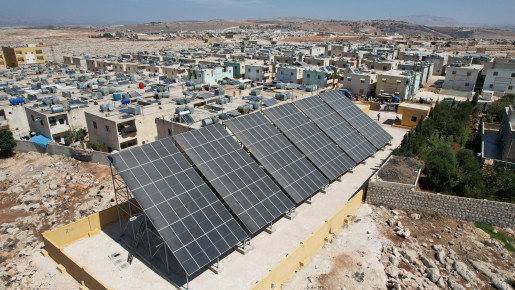Home Again: Safe and dignified
Published: Oct 18, 2024 Reading time: 3 minutes Share: Share an articleOne year into the devastating earthquake that struck northern Syria and southern Türkiye, stories of resilience and hope have emerged. Among those affected was Bashir, a 54-year-old father of seven whose home was damaged during the earthquake and became unsafe to live in.
Bashir lives in a world where vast numbers of schools, hospitals, shelters, and businesses were damaged or destroyed, with profound impacts on the lives of people. A UNOCHA report revealed that more than 10,600 buildings have been destroyed by the earthquakes at varying degrees, including at least 1,000 primary and secondary schools. Nearly a third of the 601 health facilities are non-functional, 70 of which were damaged by the disaster.
Recalling such harrowing memories was difficult for Bashir. Yet, he summoned the strength to tell us his story of fear and hope.
Bashir’s family realised they had to find an alternative place to live—this came in the form of a tarpaulin sheet that they hung between a tripod and a ladder. The family took shelter beneath this tarpaulin for two weeks until a benefactor offered them a tent. This little so-called tent may have protected the family from the heavy rain, but it did not protect them from the freezing cold.
“The water sometimes froze in the morning. We had to endure this as we didn’t feel safe going back into the house,” Bashir clarifies. ¨
Hope, Safety and Dignity Revival through Home Rehabilitation
With generous support from Swiss Solidarity, we launched a shelter project to restore and rehabilitate houses impacted by the earthquake in Northwest Syria.
Bashir was among the 58 people in his village whose homes were rehabilitated “Currently, PIN is rehabilitating my house. They have constructed building foundations and pillars. They also rebuilt the damaged walls and provided us with a door and windows,” he says.
With no livelihood beyond a small plot of land they used to plant vegetables, the family struggled to make ends meet. Bashir was grateful he had his home rehabilitated and “made even better than before the earthquake.”
“I would like to thank everyone who worked on this project. Without it, I wouldn’t have been able to repair my house. I would have stayed in this tent forever,” Bashir concludes.
Rehabilitation in frontline areas, a lifeline to dozens of families
The hardships of being in distress after thirteen years of war were doubled as people in this village became close to the frontline three years ago. “Our rehabilitation of earthquake-damaged homes in five villages in northern Syria was extended to restore damaged homes in Al-Jinah, a frontline village,” says Thaer, a Shelter Coordinator with PIN in northwest Syria.
Frontline villages are relatively dangerous places to live, and working opportunities or access to livelihoods and farming lands are limited. To address these concerns and restore the safety and dignity of such families, we rehabilitated 54 homes in a frontline village in Aleppo governorate, northwest Syria.
“Our work included a detailed village survey and engineering structural assessments for the damaged homes. Rehabilitation work included reconstructing and plastering damaged walls, installing pillars and bridges where necessary and water, sewage, and electricity repairs,” adds Thaer.
Up to now, our early recovery efforts in Northwest Syria, under the shelter programme, managed to restore the sense of safety, stability and security to 185 households in five towns and villages in Idleb countryside and 54 households in a frontline village in rural Aleppo; thanks to funds from Swiss Solidarity.


